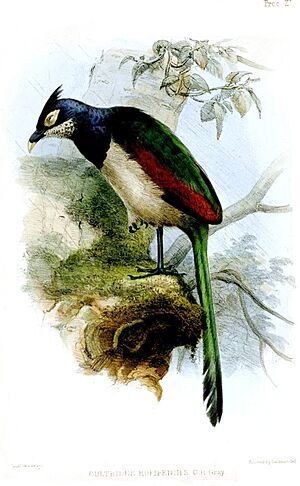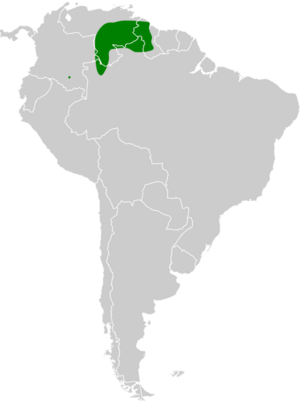Rufous-winged ground cuckoo facts for kids
Quick facts for kids Rufous-winged ground cuckoo |
|
|---|---|
 |
|
| Illustration based on specimen. The skin around the eyes is red in living individuals | |
| Conservation status | |
| Scientific classification | |
| Genus: |
Neomorphus
|
| Species: |
rufipennis
|
 |
|
The rufous-winged ground cuckoo is a special kind of cuckoo bird. Its scientific name is 'Neomorphus rufipennis'. You can find this bird mainly in countries like Brazil, Guyana, and Venezuela. It might also live in Colombia. This bird is part of a group of cuckoos called Neomorphini.
Contents
About This Bird
The rufous-winged ground cuckoo is a unique bird. It is the only species in its group, meaning it does not have any subspecies. Sometimes, people thought the birds in the western part of its home range were a different species. But now, scientists agree they are all the same kind of rufous-winged ground cuckoo.
What Does It Look Like?
This cuckoo is quite a large bird. It can be about 48 to 56 centimeters (19 to 22 inches) long. About half of its length is its tail! Male birds usually weigh around 435 grams (15 ounces). Females are a bit lighter, weighing about 325 grams (11 ounces).
Both male and female birds look similar. They have a strong, curved beak that is black. The tip of the top part of the beak is greenish or greenish-white.
- Head and Neck: Their head, crest (feathers on top of the head), neck, and upper back are a deep purplish-blue color.
- Body: The lower part of their back and the feathers covering their tail are olive green.
- Tail: The inner tail feathers are a shiny metallic purple. The outer tail feathers are black with a green shine.
- Wings: The main flight feathers on their wings are bluish-black. The other wing feathers are a dark brownish-red.
- Eyes: They have bare skin around and behind their eyes. This skin is bright red or reddish-violet.
- Throat and Chest: Their throat is a dark gray color. The feathers on their lower throat have black edges, which makes them look a bit scaly. Their upper chest is black. The lower chest and belly are a dull brownish-gray. The feathers under their tail are also gray.
Young birds look a bit different. Their upper body is mostly brownish-gray. Their lower back and rump (the area above the tail) are black. Their underside is gray.
Where Does It Live?
The rufous-winged ground cuckoo mostly lives in eastern Venezuela, western Guyana, and the far northwestern part of Brazil. There has been one sighting in Colombia. Because of this, scientists think it might live there too, but they are not completely sure. Another sighting happened in Suriname, but this has not been officially checked yet.
This bird likes to live in old, untouched evergreen forests. It also lives in "terra firme" forests, which are forests on high, dry ground. You can find them in the foothills, at heights between 100 and 1100 meters (330 to 3600 feet) above sea level.
How Does It Behave?
Movement and Travel
The rufous-winged ground cuckoo stays in the same area all year round. It does not migrate to different places.
How It Moves Around
This cuckoo spends almost all its time on the ground. It mostly walks or runs on the forest floor. If it needs to escape from a predator, it might fly low to the ground. It can also hop onto low branches. When it catches prey, it often makes quick leaps.
What It Eats
The rufous-winged ground cuckoo mainly eats insects. But its diet also includes many other small creatures with exoskeletons, like spiders. It also eats small animals such as lizards, frogs, and even small birds. Sometimes, it eats fruits too.
These birds are clever hunters. They often follow groups of army ants. They also follow peccaries (wild pigs) and monkeys. They do this to catch prey that is trying to escape from the ants, peccaries, or to eat fruits that monkeys drop.
Life Cycle and Reproduction
Scientists do not know much about how the rufous-winged ground cuckoo breeds. Its nest has never been described. It seems that their nesting season might be from March to September.
What Sounds It Makes
The rufous-winged ground cuckoo has a special call to mark its territory. It is a loud, strong "whOOu" sound. It sounds a bit like a dove's call, but it is clearer and louder. It can repeat this call for several minutes. Another sound it makes is a low, rumbling "gr’r’r."
These birds also make a dry, clacking sound by clapping their beaks together. This sound might be a way to copy the sound of peccaries. Peccaries are wild pigs that can protect their group from danger. By mimicking peccaries, the cuckoo might trick predators into thinking that peccaries are nearby. This could help both the cuckoo and the peccaries by warning each other about predators.
Conservation Status
The IUCN (International Union for Conservation of Nature) has listed the rufous-winged ground cuckoo as a species of "Least Concern." This means that it is not currently in immediate danger of disappearing.
Even though it has a large home range, scientists do not know how many of these birds there are. They believe the number of birds is slowly going down. No big threats have been found right now. However, this bird needs healthy, old tropical forests to live. So, if forests are cut down or broken into smaller pieces, it could harm the rufous-winged ground cuckoo.


